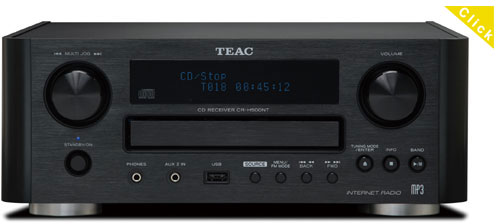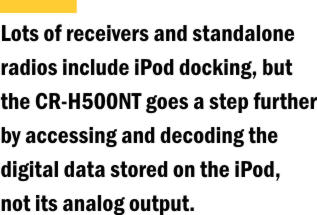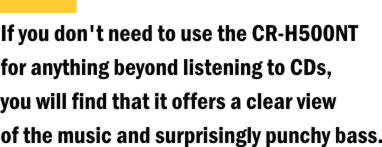TEAC Reference • CR-H500NT Receiver/CD Player
EAC and Esoteric have always been distinct brands, the former for mass-market consumer products and the latter for high-performance audio electronics. This division of purpose changed somewhat with the introduction of the TEAC Reference Series, a line of electronics and speakers meant to bridge the gap between TEAC and Esoteric. But this tells only a cursory part of the story. TEAC Reference includes a handful of products whose deep feature sets differentiate them from literally everything else in the electronics market, regardless of cost.
Sitting in the middle of these is the CR-H500NT, which, on first glance, appears to be a combination CD player and stereo receiver. However, this description is akin to calling the iPhone a mere telephone. While the CR-H500NT certainly provides power for a pair of speakers, switching for multiple inputs, AM/FM reception, as well as the ability to play CDs, it also goes far beyond any of these functions, acting as the centerpiece of a modern digital audio system. Its AKM 24-bit/192kHz digital-to-analog converters can decode data from a number of sources, including thumb drives, iPods and the Internet itself. More specifically, the CR-H500NT can both play from and record to a USB thumb drive and connect to the Internet via built-in WiFi or Ethernet hardware, allowing streaming of all manner of audio content, including from networked computers. Perhaps more unique, and of greatest interest to audiophiles, is the unit's iPod connectivity. Unlike so many digital-ready receivers and radios, the CR-H500NT is able to access data from the iPod in its digital form, bypassing the analog processing and leading to better sound. While all of these features many seem daunting, they are surprisingly easy to access and use. Take Internet radio, for example. If you do any listening to radio on the Internet, you know that just about every on-air station also streams its programming, and there are many Internet-only radio stations, whose numbers continue to grow every day. I live in an area where reception is an issue, especially with the NPR stations that I listen to most often. Yes, I can always listen with my laptop, but doing so cuts down on processing power and bandwidth, and I don't have my computer connected to the audio system in my office, so I'd have to listen through the tiny, tinny built-in speakers. Configuring the CR-H500NT as an Internet-radio receiver was surprisingly simple. The unit immediately "saw" my WiFi router, after which is was a matter of using the front-panel controls to find and save stations. Alternately, I could have accessed the Internet-radio portal that provides service for the CR-H500NT, created an account, and managed usage there. This is certainly more work than simply adjusting the unit's AM/FM tuner, but the payoff is greater as well. Want to listen to a station in Green Bay, Wisconsin, to hear the latest news on the world-champion Green Bay Packers? The CR-H500NT makes it possible, even if you live half a world away. One of the more unusual things I did with the CR-H500NT bridged a huge span in both time and technology: I recorded a bunch of 78rpm records. I have a dedicated DJ turntable for 78 playback and an inexpensive 78-ready phono stage as well. As any 78 aficionado knows, play times are incredibly short -- about four minutes per side -- but the repertoire is often rare, if not unique, having never made it to LP, let alone CD. Early Sinatra and Duke Ellington sides are easy to find, but Red River Dave's Authentic Hillbilly Ballads [Musicraft 60] is not. Here, the CR-H500NT was invaluable, allowing me to record side after side onto a thumb drive, then play them back as one extended program.
There is more -- much more, including tone controls and a moving-magnet phono input. And though it's easy to forget, the CR-H500NT also plays CDs -- and records from them too. The unit's size is also a feature. It takes up roughly half the space of a traditional receiver. While most diminutive A/V products are more plastic than any other material, the CR-H500NT has an aluminum faceplate and side plates, giving it the feel of quality. The included remote control maintains this, providing access to all of the unit's features. Output power is 40Wpc via class-D amplification, and this is one area of concern with the CR-H500NT. A notice on the back warns of using speakers whose load is 6 ohms or lower, meaning that while the amplifier has reasonable power, it can't cope with a low-impedance load. However, the likelihood of the CR-H500NT being used to drive a pair of punishing audiophile speakers is slim, given its price. Most of the speakers that will be paired with it, like my Infinity Primus 150s or TEAC's own, will work without a hitch. Of equal concern is the CR-H500NT's binding posts, which are small in diameter and accept of only bare wire, pins or banana plugs. I was able to insert of the tines of the spade connectors for my DH Lab speaker cables, but this is a substandard workaround, as the other tines are hanging free and in close proximity to each other. As with the speakers themselves, the speaker cables used with the CR-H500NT are not likely to be hose-like audiophile wires, so TEAC's solution is reasonable, especially given the tight real estate on the CR-H500NT's rear panel. Office space ike many audiophiles with elaborate two-channel rigs built around large floorstanding speakers, heavy mono amps, and sources of the highest quality, I have a second system in my office that's of lesser pedigree. This is a matter of necessity and also of space. This system is arrayed to fit in with everything else stored in the office, while my reference rig literally dominates the large room in which it's rooted. Still, if saving space was all that mattered to me, I'd be using a portable CD player/radio instead of setting up in my office a full-blown audio system with turntable. However, I'm simply not willing to trade sound quality for convenience. In this system, the CR-H500NT proved challenging to evaluate. It performs so many functions, and accommodates music recorded in so many ways, that discerning its intrinsic sonic personality was a matter of careful dissection, which took literally months of trial and a modicum error. The CR-H500NT made me wistful for the days of reviewing an amplifier or CD player, instead of a multifunction digital control center.
The CR-H500NT's moving-magnet phono stage was functional though by no means spectacular. In all likelihood, a 'table such as my Gemini DJ model will be used with the CR-H500NT, in which case the ultimate substance of analog playback will come down to the cartridge. My Grado Prestige 78E is for 78s only, but I also mounted an Ortofon 2M Blue on the 'table and its personality came shining through. Still, the phono stage was soft dynamically and in terms of its retrieval of detail, LPs sounding less varied and distinct. However, for some, recording vinyl to thumb drive (MP3 at 128kpbs) may make the CR-H500NT a must-buy proposition. Not only will they not have to buy a cheap, throw-away USB turntable and rely on its low level of fidelity, but the whole process is very easy and intuitive. As I mentioned, I used the CR-H500NT to record 78s, which are fidelity-challenged to begin with, and the outcome was virtually indistinguishable from direct playback. This also made listening to 78s a pleasure -- no frequent trips to the turntable to flip the record or put on a new one. Frankly, this alone makes the CR-H500NT almost indispensable. As does its Internet radio, at least for me, as I monitor NPR throughout the workday. Wireless or wired streaming of music to the CR-H500NT was easy too, although I can't say I did much of it. I don't own an iPod, so I didn't test the CR-H500NT's ability to extract digital data from it at all, although, again, this feature alone may be a deal-maker for some. All of this underscores the fact that the true allure of the CR-H500NT is what it does -- the ways in which it will expand your musical horizons. In this regard, comparing the CR-H500NT to an A/V receiver or two-channel integrated amp is like comparing apples and orangutans. While the CR-H500NT took the place of another TEAC product in my office system, an A-1D integrated amp ($300), the two are as different as such products can be. The A-1D is a traditional stereo integrated amp that outputs 50Wpc via a MOSFET amplifier section. It doesn't have the load restrictions of the CR-H500NT and is able to drive most speakers well. As its MOSFET output devices might suggest, it full, warm sound works very well with speakers that have a cool overall character, like my Infinities. The CR-H500NT sounds noticeably lighter and clearer, though less robust through the midband and into the bass. I would choose it on sonic grounds alone, and its many features only make the choice easier. Even when compared to better-sounding integrated amps and receivers, the CR-H500NT will hold its own simply because of the many things its competition can't do. High-functioning high end spend almost all of my reviewing time listening to components in the rarefied leagues of high-end audio. Given this, a product like the CR-H500NT is a potent reminder that performance is more significant when its paired with functionality. In terms of what I am able to do, I've not encountered a product like the CR-H500NT -- not even close, in fact. It can play music from a number of digital sources, including iPod and a networked computer, and record music to a thumb drive for later playback. It also plays old-school CDs and AM/FM radio, though its Internet-radio functionality may make you forget about the latter. Its build quality is a step above the mass market, and its sonic performance is too. Other than TEAC's own AG-H600NT, which promises even better sonic performance, though at twice the price, I know of no other product like it. Or, put another way, I know of many products
like it -- many separate and distinct products, a handful of which would be needed to take
its place. Just add speakers to the CR-H500NT and you'll have a thoroughly modern,
thoroughly satisfying music system.
|


 Perhaps the CR-H500NT's greatest
digital feat is its ability to stream music from an iPod. Lots of receivers and standalone
radios include iPod docking, but the CR-H500NT goes a step further by accessing and
decoding the digital data stored on the iPod, not its analog output. This essentially
turns the iPod into a handheld music server that can provide music at CD resolution (16
bits and 48kHz maximum) in .wav, .aiff and Apple Lossless formats.
Perhaps the CR-H500NT's greatest
digital feat is its ability to stream music from an iPod. Lots of receivers and standalone
radios include iPod docking, but the CR-H500NT goes a step further by accessing and
decoding the digital data stored on the iPod, not its analog output. This essentially
turns the iPod into a handheld music server that can provide music at CD resolution (16
bits and 48kHz maximum) in .wav, .aiff and Apple Lossless formats. If you don't need to use the
CR-H500NT for anything beyond listening to CDs, you will find that it offers a clear view
of the music and surprisingly punchy bass. Tonality is more on the lean than full side,
while the high frequencies are nicely extended, even finely detailed, though also somewhat
lean. You might be wondering how I can comment on the "surprisingly punchy bass"
when the speakers in my office system are challenged to go much below 100Hz. Well, for
edification, I also used the CR-H500NT with a pair of Wilson Audio Sophia 3s, which work
well with electronics of varying pedigrees and power outputs. The Sophias are just
within the CR-H500NT's 6-ohm comfort zone. On "Root Beer" from the American
Beauty soundtrack [DreamWorks SKG 50210], the CR-H500NT/Sophia 3 combination produced
low-end heft and and more than a touch of slam. With my smallish Infinities, a subwoofer
would be in order, and the CR-H500NT can accommodate, having a dedicated subwoofer output.
If you don't need to use the
CR-H500NT for anything beyond listening to CDs, you will find that it offers a clear view
of the music and surprisingly punchy bass. Tonality is more on the lean than full side,
while the high frequencies are nicely extended, even finely detailed, though also somewhat
lean. You might be wondering how I can comment on the "surprisingly punchy bass"
when the speakers in my office system are challenged to go much below 100Hz. Well, for
edification, I also used the CR-H500NT with a pair of Wilson Audio Sophia 3s, which work
well with electronics of varying pedigrees and power outputs. The Sophias are just
within the CR-H500NT's 6-ohm comfort zone. On "Root Beer" from the American
Beauty soundtrack [DreamWorks SKG 50210], the CR-H500NT/Sophia 3 combination produced
low-end heft and and more than a touch of slam. With my smallish Infinities, a subwoofer
would be in order, and the CR-H500NT can accommodate, having a dedicated subwoofer output.